July 1997 Cayman Brac Trip Report
Text and images are copyright (C) 1997 David M. Read. All rights
reserved.

My wife, two friends and I went to Cayman Brac from July 5th to July 12th, 1997, for a
week's worth of diving at Divi Tiara Beach resort. This is a report of that trip.
Table of Contents:
|
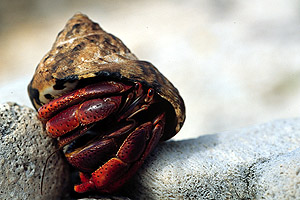
|
Introduction
"What is Cayman Brac?" "Where is Cayman Brac?" "What the
&$%^@! are you talking about?" These are the questions I was asked by friends
& family prior to our trip.
Cayman Brac is one of the three Cayman Islands, part of the British West Indies. They
are roughly 200 miles south of the middle of Cuba, in the Caribbean Sea. The other two
islands are Grand Cayman (of which most people have heard), and Little Cayman.
Other Cayman Brac resources:
Getting There
We traveled to Cayman Brac via Cayman Airways, departing through Houston and changing
airplanes on Grand Cayman (both outbound and return). I have heard horror stories about
flying Cayman Airways, but our experience was a good one. Our bags arrived with us, and
Cayman Airways didn't give us any grief about exceeding the baggage limits (we checked 5
bags for the two of us, which was one bag over the stated limit).
My only complaint about Cayman Airways' service is regarding their flight schedules.
They have a 5:40pm flight from Houston to Grand Cayman, which arrives at 8:30pm, but the
connection to Cayman Brac doesn't leave until 10:15, despite being the same physical
aircraft. Worse still, the only flight departing the Brac leaves at 6:15am, with the
connection to Houston departing at 2:05pm. It really sucks to wake up at 4am to make a 6am
flight just so you can have a 7 hour layover before proceeding home. Grand Cayman is a
relatively dull place to get stuck for 7 hours, considering that you can't dive during
that period. You can't even go snorkel Stingray City, because the trips out there are all
from 10:00am to 1pm, which is pushing your luck for making your flight. All things
considered, I would try to schedule a one- or two-day layover on Grand Cayman to do a
little diving. Cayman Air will charge you extra for that, however. :(
It's worth mentioning that Miami-bound passengers don't even change planes on G.C. on
their way home from the Brac. Anyway, once on the Brac we rented a car from Avis at the
airport; a 7-day rental of a Ford Escort cost us $245. Gasoline on the Brac runs about
$2/gallon. The car rental was worth every nickel (read on to see why); I highly recommend
it.
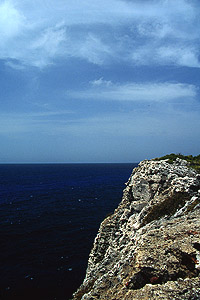
From the Bluff at the east end of
Cayman Brac you can find some great places to watch the sun rise! |
The Island
Cayman Brac itself is a beautiful island, and relatively sparsely populated. Compared
to some other Caribbean islands we have visited, it is also relatively modern, yet it
still displays a homey rural charm. The natives are very interested in lawn work, and do
an amazing job of keeping their homes beautiful.
Two or three paved two-lane roads provide access to most of the island, electricity and
fresh water are readily available, and there are several small grocery stores where
supplies and supplements can be purchased. Telephone service on the island is present,
although somewhat expensive and difficult to use. The island people ("Brackers")
are very friendly and open towards tourists, and quite willing to talk your ear off if you
give them the chance. If you plan to go souvenir shopping, I recommend avoiding N.I.M.
Things until you have visited every other store on the island. N.I.M. Things
has some pretty cool knick-knacks and "island art," but it's very difficult
to escape N.I.M. without investing a solid hour of tall-tale listening.
Driving the island is fun, once you get used to driving on the left side of the road.
It's easy, as long as you get in to the habit of chanting "drive on the left...drive
on the left..." every time you make a turn! The roads are only lightly trafficked,
and generally in decent condition. At night there is almost no-one on the road. I think I
went the whole week without hearing a car horn. |
The Resort
We stayed at Divi Tiara Beach Resort, in the timeshare section of the resort (so I
can't tell you much abut the "regular" rooms). The time share rooms were great,
though, supplying ample room for the four of us. An inner room is air-conditioned and
contains two full-size beds. This room is surrounded on three sides by a screened,
shuttered patio which is home to another bed, a kitchenette (stove, sink, fridge), an
extra "dorm" fridge (which we used for film storage), a dining table, and a
Jacuzzi (which was our personal camera rinse tank for the week, since we had three still
cameras and a video setup for the four of us). The forth side of the bedroom is bordered
by a small hallway and the bathroom.
The resort is "full-featured," to say the least. It sports a restaurant,
several small shops, a decent-sized fresh-water swimming pool, a tennis court, a beachside
bar, a full-service photo shop (including Nikonos and video rentals, plus E-6 film
processing), and a dive shop. There is very little you might need which you can't find at
the resort. |
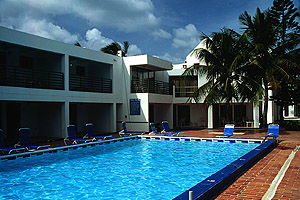
Tiara's pool provides a refreshing rinse for divers
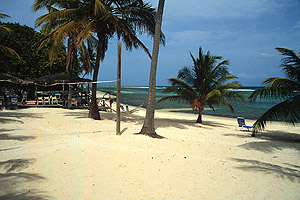
Relax at the bar, play volleyball, or just snooze on the beach. |
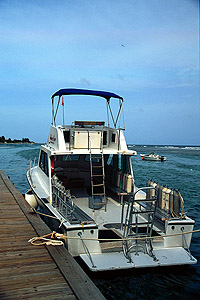
One of Dive Tiara's boats awaits divers 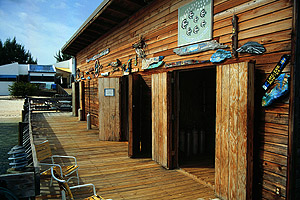
Dive Tiara's dive shack is open for business!
|
The Diving Facilities
The diving facilities at Tiara are excellent. A large dive shack allows each guest to
have his/her own hook. The way they operate is this: when you check in with the dive shop,
they give you a numbered mesh bag, which is yours for the whole stay. You place your gear
in the bag and hang it on the hook of the same number, then set up you weight belt and
place it on the floor under your bag. If you like, this is the last thing you'll have to
do with your gear until you pack it to go home. The dive staff retrieve your bag for each
trip (when you sign up for a dive, you give your bag #), place it on the boat, and set up
your gear for you! While this might alarm some people, I stopped worrying about it when
they configured my gear exactly perfectly the first three dives. I kept doing once-over
gear checks, but they got it right every time.
The service doesn't stop there, though; when you are ready to enter the water, you sit
on the swim step, don your mask and fins, and tell the DM which rig is yours. He/she
brings it to you and holds up the shoulder straps for you. Fasten your cummerbund, stand
up, and giant stride into the water!
The boats at Dive Tiara are Pro 42 twin-screw boats; they seat maybe 20 divers, and are
plenty fast. The longest ride we had all week was an hour, and that was going over to
Little Cayman. Dive Tiara owns five of these boats, but the most we saw in action was two.
I think we saw a full boat only once (yikes! crowded boat!), while the average head count
sat around 12 to 14. |
The Dive Staff
The dive staff at Tiara were excellent. They knew their stuff, they didn't interefere
with divers having fun, and they provided assistance to divers who needed it. That's
really all I want from a DM. They gave us great tips on where to find stuff, and told us
where to go for shore diving. They gave no grief about us checking out tanks for our night
dives, and even loaned us a cart for hauling tanks from the dive shack up to the parking
lot. They were friendly, out-going, and apparently loved their jobs.
The dive staff were safety-conscious, but they also knew that divers generally like to
do their own things. Here was the standard pre-dive warning: "If you're diving the
tables, your maximum depth is 100 feet. If you're diving computers, 110. Please turn
around at 1800 psi or half your bottom time. Locate the boat with 1000 psi, and be back on
the boat with at least 500." I'm sure the DMs checked my air when they broke down my
gear, but I never saw them checking the computer for max depth. In general, I think they
were very relaxed and willing to let us have fun.
The Diving
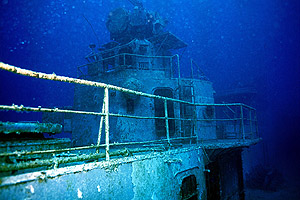
The bridge of the M/V Keith Tibbetts

One af Cayman Brac's many Tiger Grouper

Strawberry Vase Sponges abound in the Brac's waters |
The dive conditions were generally good, but not what I would call
excellent. Mostly this resulted from bad weather; a tropical wave moved through the region
during the week, producing some strong winds and choppy seas during the days. This
resulted in lower-than-normal visibility (or so I'm told); most dives had 40-50 foot vis,
while a few peaked at 75 or 80 feet. There were some pretty impressive lightning shows off
in the distance at night, and at least one heavy rainstorm. Regardless, most nights
delivered calm seas, and we did our share of night diving. Water temperatures stayed at
a constant 85 F throughout the week, while the air temps ranged from low 70s to high 90s.
The good news is that the reefs are healthy, and the fish life is abundant. We didn't
see any large pelagic critters, but we saw just about everything else. I would call the
Brac "macro heaven." The list of critters is too long to give in complete, but
here are the highlights (for me): black durgons, queen triggerfish, queen, french and grey
angelfish, honeycomb cowfish, several species of snapper, several species of grouper,
barracuda, several species of puffer, southern stingrays, yellow stingrays, spotted eagle
rays, turtles, juvenile yellowtail damselfish (always my favorite!), juvy spotted drum,
flamingo tongue cowries (lots of 'em), fairy basslets, sailfin blennies (very cool),
octopus, scorpionfish, and much more.
I learned that black durgons can change color; I noticed this very aggressive durgon
chasing away two others. Its forehead was bright pink and orange, lined with blue and
green. After the other two took off, I was amazed to watch the bright one's forehead turn
back to a solid black over a two- or three-second period. Too bad I was out of film! |
The Dive Sites
Here is a list of dives I made during the week, in the order they were made. The dive
numbers refer to the dives made this week, not the dive # in my log book.
Dive #1 Sunday morning, 6 July: "Russian Destroyer #356," a.k.a. M/V Keith
Tibbetts.
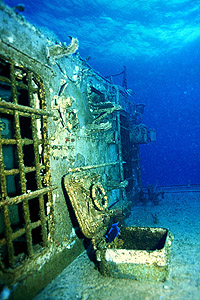
The M/V Keith Tibbetts is starting to attract sea life |
This is the hot dive on the Brac, at least until you dive it. It's
actually a frigate, and it's actually Cuban (although built by the Soviet Union), so
"Russian Destroyer" is a horrible misnomer. However, it's the name that sticks,
so... The dive is pretty cool; the wreck sits upright, the stern deck at about 30 feet,
the foredeck at about 60. The top of the radar tower is maybe 20 feet deep. The deepest
you'll need to go is 90 feet, and that's only if you want to swim under the bow, which
sticks out from the sandy slope. In the sand beneath the bow is a plot of garden eels,
which one of the DMs showed me how to catch. The wreck is very well lit, and fun to
swim around. There is not much growing on it yet, and only a few resident critters (most
of them small). It's still an awesome sight, though, and it's littered with daylight
swim-throughs for non-wreck divers. There is a great one where you can swim through the
bridge from side to side.
All in all, though, the wreck is a do-once dive for me. There were plenty of more
interesting dives on the Brac. |
Dive #2, Sunday morning, 6 July: "Snapper Reef"
| Very cool dive. Lots of cleaning stations, and I got to see a Barracuda
getting cleaned. I even watched a cleaner wrasse dart in and out of the Barracuda's
mouth. Other marine life we found at this site included: a yellow stingray, flamingo
tongues, several juvenile yellowtail damselfish, a juvy spotted drum, and a juvenile
slender filefish flitting about a finger sponge. The slender filefish is one
strange-looking creature! The reef here is all spur and groove formations, which I
personally adore. They make navigation easy, and provide a great variety of terrain in a
single location. The spurs are almost mini-walls where you can float up & down to look
at things, while the grooves provide sand flats for things like scorpionfish and
stingrays, and overhangs near the sand for things like octopus. This particular site also
allowed for shallow profiles; the bottoms of the grooves lie at about 50 feet, while the
tops of the spurs reach as shallow as 20 feet. |
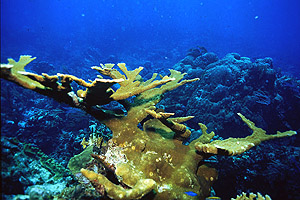
You can even find Elkhorn Coral in the shallows around
the Brac!
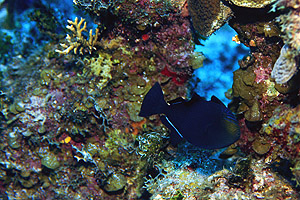
Plenty of Black Durgons swim around the Brac |
Dive #3, Sunday afternoon, 6 July: "Grunt Valley"
|
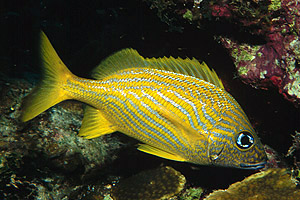
French Grunts are everywhere at Grunt Valley
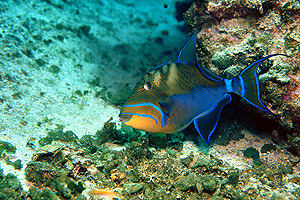
Queen Triggerfish can be found easily
|
Another great dive! The highlight of this dive was getting my hand cleaned by three
Pederson's Cleaning Shrimp. I had seen a Queen Angelfish getting cleaned while
nestled up against a rock ledge, and called my dive buddies over to see it (two of them
had never seen a cleaning station before). By the time they arrived, the Angelfish had
taken off. I swam up close to the cleaning station right afterwards to point out the
cleaning shrimp to my buddies; when I extended my hand into the "lair" to point
right at the shrimp, one of them hopped on and started picking away at my skin! I held my
hand steady for a few seconds, and then the other two shrimp hopped on, followed by a
cleaner wrasse. I let them clean for about a minute, and then shook them off and continued
the dive. I will treasure that experience forever!
The marine life on this dive included plenty of grunts (duh), a large Queen
Triggerfish, another juvy spotted drum, and plenty of snapper, fairy basslets, etc.
|
Dive #4, Monday morning, 7 July: "Cemetery Wall"
Generally I thought this dive wasn't so great. It was very deep (the wall started
at 60 feet, and the top of the wall stayed at that depth for quite a distance towards
shore), and there wasn't a whole lot of large reef life to see. I did see a huge
spiny lobster on top of the reef.
Dive #5, Monday morning, 7 July: "Patch Reef"
Patch reef is a much better dive than Cemetery Wall, IMO. I found a flamingo tongue on
a gorgonian near the bottom (maybe 30 feet), a whitespotted filefish (which I observed to
eat sea fans! I always thought the holes in sea fans were due to divers, but now I know
differently!),
Dive #6, Monday afternoon, 7 July: "Radar Reef"
| To those who say that there isn't any good shore diving on Cayman
Brac, I say "then you haven't dived Radar Reef." Radar Reef, or "Cable
Reef" as we called it, is a shore dive with extremely easy access and plenty to see.
To get to it, take the north side road east until you reach the Cayman Brac Museum, and
turn left on Kirkconnell Street. Take Kirkconnell street until it ends, at a little pier
with a small parking lot. The pier is located about 50 feet from a public boat ramp, and
there are some steps which lead into the water between the ramp and the pier. The steps
make entry and exit quite easy, and the pier acts as a nice breakwater to make the seas a
little calmer. The reason we called the dive site "Cable Reef" (before we
knew the "official" name for the dive site) is that the original telephone cable
which connected Cayman Brac to Grand Cayman starts off right by the pier. Swim to the end
of the pier, turn right and swim another 30 feet or so, and you'll pass over the
cable. The cable leads out to the reef, and makes for extra simple navigation for starting
and ending the dive. Once you get to the reef, it's all spur and groove, which means
that if you want to leave the cable, all you have to do is count spurs as you swim away,
and then count the same number back to return you to the cable. We never dove the site
deeper than about 55 feet, but there's nothing to stop someone from going deeper.
The reef teems with life, which I think is due to the relative infrequency with which
the site is visited. The site is about half-way out on the north side of the island, which
means that it's a long trip to the site for the dive operations.
Here's what we saw. If you follow the cable to a depth of about 17 feet,
you'll find the coral life beginning to crop up. There are several gorgonians, sea
fans, and other waving corals within 15 feet of the cable. A large number of these growths
sport flamingo tongues. Over 4 dives at this site, I never saw less than a half-dozen
flamingo tongues in this general area. On each dive, I found at least one gorgonian which
had multiple flamingo tongues. In other words, this dive site is macro heaven.
The area near the pier often teems with schools of thousands of silversides; three of
the four dives we did yielded huge schools.
Other marine life: yellow stingrays (in the sand flats at about 50 feet), southern
stingrays (same place), puffers, all varieties of angelfish, grouper, coneys, lots of
sponges (including strawberry vase sponges, very cool), etc. etc. |
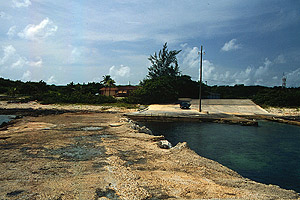
Looking in towards the parking lot from the end of
the pier at Radar Reef's entry site 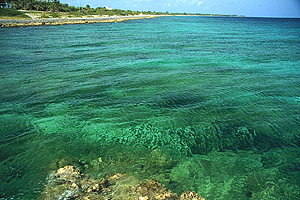
The shallow water near the pier is home to
plenty of critters
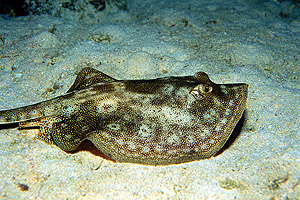
This yellow stingray played with us on a night dive
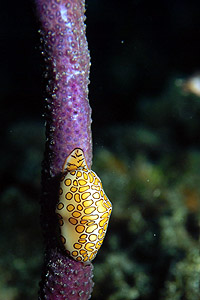
Flamingo Tongues: the macro
photographer's dream
|
Dive #7, Monday night, 7 July: "Radar Reef"
|
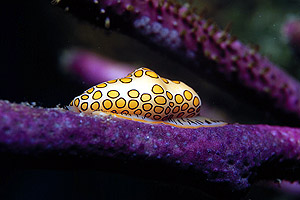
Flamingo Tongues can be found near the cable at 15-17 feet
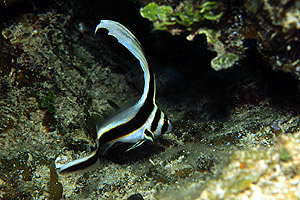
Radar Reef is home to many Spotted Drum
|
Night dive at Radar Reef. The dive site itself is described above. This dive was one
of the more incredible night dives I have ever done. It started with a huge school of
silversides, giant spiny lobsters under the rocks by the pier, red snapping shrimp on the
rocks of the pier, and a bunch of juvenile sea wasps (main portion of body no more than ¾
inch long) at the surface by the pier above the telephone cable. I didn't recognize
them as sea wasps immediately, and we got stung by them a little (not badly, though).
They're really fun to look at, but once we got stung a couple of times, we descended
and headed for the rest of the dive. The flamingo tongues were where I had last seen
them, at 17 feet depth around the cable. There was also an arrow crab under the phone
cable in that area, and a juvenile spotted drum as well. In the deeper portions of the
dive, on the sand flats around 50 feet, we saw a yellow stingray, a southern stingray, a
reef octopus, and a sleeping puffer. The puffer very obligingly swam into my hands.
On our way out of the dive, I found a scorpionfish in the sand flats at a depth of no
more than 15 feet. Man, those things are ugly! |
Dive #8, Tuesday morning, 8 July: "Middle Chute Wall"
Altogether not that great a dive. This was the day the bad weather arrived, and the
seas were rough. Lots of surge in the shallows, and generally poor visibility (maybe 50
feet). This was another north-side deep wall dive, with the wall starting at 60 feet. The
top of the wall had plenty of soft corals and sponges, but the terrain was very flat,
which makes photography difficult. All in all, I'd skip this dive site next
time.
Dive #9, Tuesday morning, 8 July: "Patch Reef"
We visited this site for the second time in two days, and it was still good. The vis
opened up a little, to maybe 60-70 feet, and the reef yielded more fish life and more
interesting terrain. The surge was worse (this is a much shallower dive), but still
bearable. Marine life this dive: a big Queen Triggerfish, porcupine puffer, a Greater
Soapfish tucked up against a rock ledge, and all the usual suspects.
Dive #10, Tuesday afternoon, 8 July: Kissimee Wreck
|
As a wreck dive, the Kissimee is nothing to write home about. It's a small boat,
maybe some sort of tug, in about 40 feet of water, surrounded by a large sand flat. The
sand was home to lots of cool critters, including stingrays, a peacock flounder, and more.
The reef around the Kissimee is also interesting, more spur and groove formations, stocked
well with fish of all varieties.
|
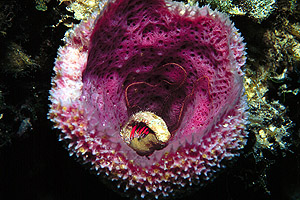
This pink vase sponge was home to several friends! |
Dive #11, Wednesday morning, 9 July: M/V Keith Tibbetts
|
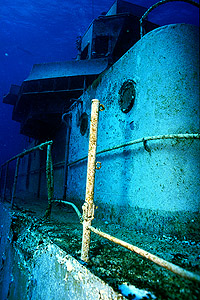
Spooky lighting on the M/V Keith Tibbetts
|
Back to the "Russian Destroyer," this time with my camera and a 24 mm lens. I
wouldn't have done this dive again except that I wanted to get some photos of the
wreck.
|
Dive #12, Wednesday morning, 9 July: "Lighthouse Reef"
Lighthouse Reef is on the south side of the island, which I think offers better diving
than the north side (in general). This was a deep spur and groove reef, with the
interesting parts starting around 50 feet. It had lots of cool swim-throughs and short
tunnels to explore, and the fish life was very dense. The sponges on the inside of the
tunnels make it worth your while to carry a dive light on this dive. The highlight of the
dive was a long, face-to-face encounter with an inquisitive honeycomb cowfish.
Dive #13, Wednesday afternoon, 9 July: "Butterfly Reef"
|
Butterfly Reef is another south side reef, known for the density of butterflyfish. This
one was very shallow, which always makes me stay longer; I love floating around in the
surge and the bright natural light, just observing. Plenty of juvenile fish of many
varieties, some elkhorn coral, some pillar coral, and generally interesting terrain. This
site is also spur and groove, although some of the spurs are more like little mountains or
pinnacles than they are like traditional spurs.
|

One of Butterfly Reef's inhabitants
|
Dive #14, Wednesday night, 9 July: "Radar Reef"
|
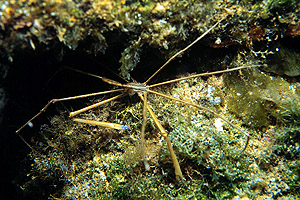
Look under the cable to find Arrow Crabs!
|
Back to "Cable Reef" for another night dive. The reef life
wasn't as plentiful as on previous dives, and the visibility was a little worse, but
still I love night dives. Another stingray, plenty of lobster and shrimp, more juvenile
spotted drum, many more flamingo tongues (again at 17 feet around the cable), but the real
thrills were the two schools of baby reef squid (about 10-20 squid per school), at depths
no more than 10 feet. We also saw our first (and only) eel of the entire Cayman Brac trip,
a sharptail eel at about 20 feet near the phone cable. |
Dive #15, Thursday morning, 10 July: "Eagle Ray Roundup," Jackson Bight,
Little Cayman
|
As much as I enjoyed the diving on Cayman Brac, I have to admit that I thought the
diving on Little Cayman smoked that of the Brac. The wall on Jackson Bight (within
eyesight of Bloody Bay) started at 50 feet, but it was completely vertical and covered
with all manner of coral, fans, and sponges (including lots of strawberry vase sponges).
The shallows by the wall offered sand flats with lots of cool overhangs, tunnels, and
swim-throughs. Again, a dive light was a necessity for this dive, because the tunnels were
lined with brightly colored sponges.
The sand flats were also home to a half-dozen southern stingrays cruising around, each
with a bar jack swimming above it. Playing with the rays was great fun.
|
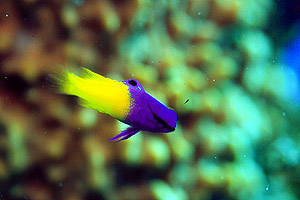
Fairy Basslets are everywhere! |
Dive #16, Thursday morning, 10 July, "West Great Wall," Bloody Bay, Little
Cayman
|

Looking up from Bloody Bay Wall
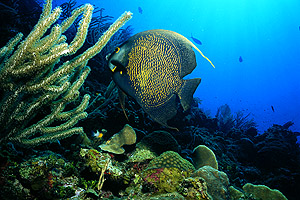
There are things to see on top of Bloody Bay Wall, as well!
|
Bloody Bay Wall was all I had ever heard about it. This was one of the
most astounding dives of my life. The wall starts very shallow, in just 30 feet of water.
It's completely vertical, and teeming with life. Pick a Caribbean fish, and I
probably saw it on this dive. This was the dive site where I learned that black durgons
can change color. The wall itself, although fascinating and captivating, was not the
best part of the dive. The best part was spending 40 minutes in a fin-cross float,
hovering above the reef. I pretended to be a piece of flotsam, allowing the surge to take
me where-ever it wanted me to go. Once the other divers left the area, the reef came even
more alive, as every manner of reef creature came out from hiding. Lobster, a few small
crabs, wrasse, gobies, you name it: they all came out to play. The black durgons in the
area formed a school and started cruising around as a group. The school of 50 of them swam
right around me, offering close-up views (less than 1 foot) of several of them.
I will remember Bloody Bay Wall forever. |
Dive #17, Thursday afternoon, 10 July, "Snapper Reef"
|
Back to Snapper Reef for a shallow afternoon dive. I got my hand cleaned by another
group of Pederson's Cleaner Shrimp, and saw all sorts of cool fish. More juvenile
spotted drum, a couple of arrow crabs, queen and gray angelfish, another greater soapfish,
and a very cool juvenile which looked like a small indigo hamlet, but with yellow areas on
the tail and the cheek. I identified the fish using (Paul Humann's book) as a
juvenile blue angelfish, but the book claims that they are not found in the area, so
perhaps it was a juvenile queen angel, which looks similar. Regardless, it was quite a
beautiful fish!
|
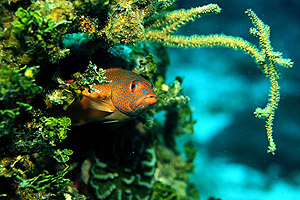
Peek-a-boo! I see you! |
Dive #18, Friday dawn, 11 July, "Radar Reef"
|

Watch where you put your fingers when diving
Radar Reef! This scorpionfish was snuggled up the
telephone cable.
|
Our last dive of the trip was supposed to be a dawn dive, but we arrived at the dive
site a little too late; the skies were already fairly light, and by the time we got to 50
feet, all the night-hunters had gone away. It was still a great dive. Yes, the flamingo
tongues were still out in force at 17 feet around the cable. We saw the giant schools of
silversides, another yellow stingray, more arrow crabs, a giant puffer, several juvenile
spotted drum, and a huge scorpionfish nestled up against the cable at about 15 feet. |
Dive Log
| Dive # |
When |
Where |
Depth |
Time |
Comments |
| 1 |
Sunday 9:30 AM |
M/V Keith Tibbets |
89 |
47 |
First dive at the "Russian Destroyer." Garden Eels beneath the
bow at 90 feet. |
| 2 |
Sunday 11:00 AM |
Snapper Reef |
50 |
56 |
Spur & groove reef, lots of life |
| 3 |
Sunday 3:00 PM |
Grunt Valley |
52 |
52 |
Plenty of grunts, plenty of natural light |
| 4 |
Monday 9:30 AM |
Cemetery Wall |
97 |
38 |
Deep wall, not much on top |
| 5 |
Monday 11:00 AM |
Patch Reef |
38 |
43 |
Cool spur & groove with pillar coral formations |
| 6 |
Monday 5:00 PM |
Radar Reef |
58 |
55 |
"Cable Reef" to us, this was one of my favorite Brac dive
sites. |
| 7 |
Monday 9:00 PM |
Radar Reef |
42 |
41 |
Night dive! Stingrays, octopus, scorpionfish, lobster, shrimp, puffers,
arrow crabs, flamingo tongues, juvenile sea wasps. This dive had it all. |
| 8 |
Tuesday 9:30 AM |
Middle Chute Wall |
85 |
42 |
Another deep wall with little on top. |
| 9 |
Tuesday 11:00 AM |
Patch Reef |
36 |
46 |
Back to the cool terrain! |
| 10 |
Tuesday 3:00 PM |
Kissimee Wreck |
48 |
46 |
Minor wreck; the real fun is in the sand flats and surrounding reef. |
| 11 |
Wednesday 9:30 AM |
M/V Keith Tibbets |
72 |
42 |
Back to the destroyer for photos |
| 12 |
Wednesday 11:00 AM |
Lighthouse Reef |
52 |
41 |
Very cool dive site. Deep spur & groove, lots of tunnels
and swim-throughs. |
| 13 |
Wednesday 3:00 PM |
Butterfly Reef |
44 |
1:01 |
Another cool dive site. Lots of pillar coral, elkhorn coral, and plenty
swimming around. |
| 14 |
Wednesday 8:30 PM |
Radar Reef |
52 |
40 |
Another night dive on the telephone cable. Baby squid,
stingrays, and the only eel (sharptail) of the trip. |
| 15 |
Thursday 10:00 AM |
Eagle Ray Roundup
Little Cayman |
110 |
51 |
Little Cayman! Lots of stingrays, swim-throughs, bright
sponges, and more. |
| 16 |
Thursday 11:45 AM |
West Great Wall
Little Cayman |
82 |
1:10 |
Bloody Bay Wall, the best dive of the trip! Incredible life,
incredible coral, etc. |
| 17 |
Thursday 3:00 PM |
Snapper Reef |
42 |
46 |
Great juvenile life, in the shallows. Look around the coral pillars to
see all the little fish! |
| 18 |
Friday 5:30 AM |
Radar Reef |
53 |
1:02 |
Dawn Dive (well, almost)! Last dive of the trip, saw plenty. Highlight:
giant spotted scorpionfish. |
|




























